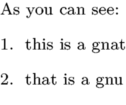Difference between revisions of "Command/startitemgroup"
< Command
Jump to navigation
Jump to search
(Created page with "Documentation for \startitemgroup ... \stopitemgroup") |
|||
| Line 20: | Line 20: | ||
</cd:command> | </cd:command> | ||
</cd:variants> | </cd:variants> | ||
| − | <cd:description>This is the generic command to start | + | <cd:description>This is the generic command to start a named enumeration block. It can be used as an alternative to the command to start a named block, like {{cmd|startitemize}} for example.</cd:description> |
<cd:examples><cd:example title=""><context source="yes"> | <cd:examples><cd:example title=""><context source="yes"> | ||
\startitemgroup[itemize][n] | \startitemgroup[itemize][n] | ||
Latest revision as of 11:50, 14 September 2023
Contents
\startitemgroup ... \stopitemgroup
Summary
The environment \startitemgroup ... \stopitemgroup is used to start an enumeration block
Settings
| \startitemgroup[...][...,...][...=...,...] ... \stopitemgroup | |
| [...] | name |
| [...,...] | inherits from \setupitemgroup |
| ...=...,... | inherits from \setupitemgroup |
Description
This is the generic command to start a named enumeration block. It can be used as an alternative to the command to start a named block, like \startitemize for example.
Examples
Example 1
\startitemgroup[itemize][n] \sym{As you can see:} \item this is a gnat \item that is a gnu \stopitemgroup
